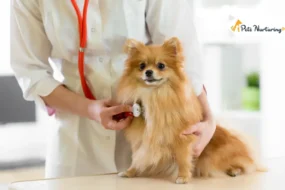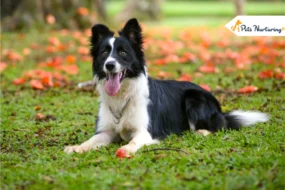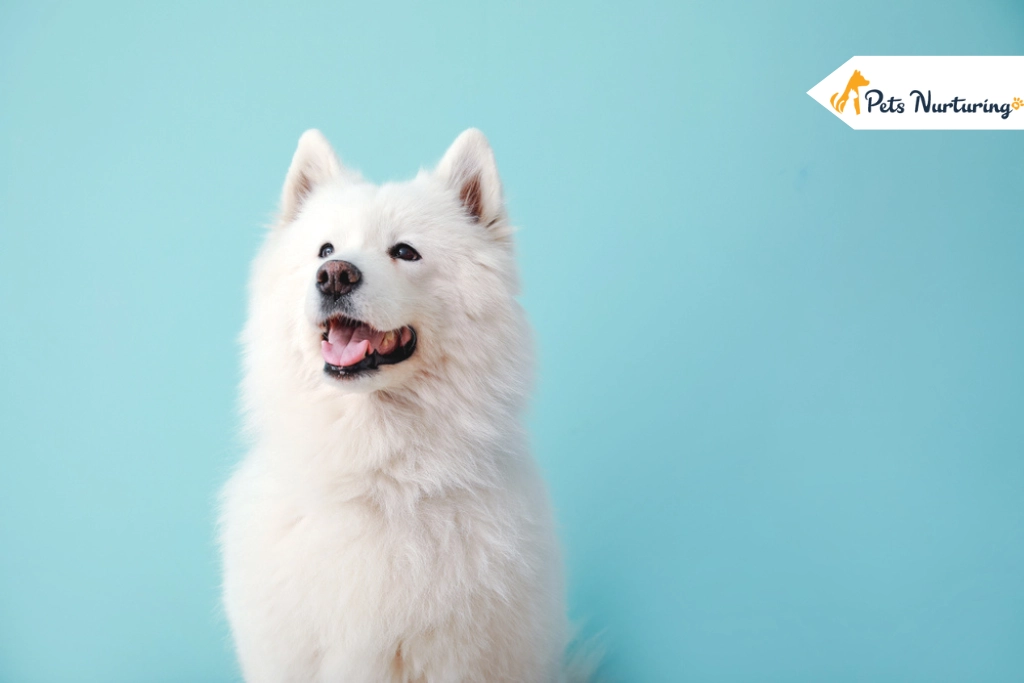
If you are looking for a dog with a beautiful white coat, Samoyed Dog is the best choice. These dogs have fluffy, snowy-white fur with a curly tail that almost makes them look like teddy bears. Samoyed makes great pets due to their loving and friendly nature. They have cute faces that almost look as if they are smiling from ear to ear.
These dogs are hard workers and can be a bit headstrong, yet they’re very friendly, gentle, and loyal family companions. They love almost everyone they meet and are easy-going compared to other dogs.
If you’re thinking about getting a Samoyed dog, it’s best to read our guide. We’ll cover all the information about these dogs, from their origin and characteristics to their training and grooming needs. It will help you decide whether Samoyeds are right for your home.
Breed Overview
The Samoyed is a big Siberian working dog with pointed ears and a thick double coat. They are one of the cutest dog breeds in the world.
People often call them “Sammies” because of their thick, fluffy white fur. These gentle giants love attention and are willing to help out, whether it’s herding, hunting, or pulling a sled for their humans.
Sammies are built for cold weather. Their double coat keeps them warm, and their upturned mouths stop drool (and icicles) from forming on their lips.
But despite being tough, they’re equally happy being a family pet or doing a job. With their friendly personalities, Samoyed dogs are awesome companions as long as they receive lots of love and care.
Samoyed Dog Overview
Breed Group: Working
Height: 21 to 23.5 inches (male), 19 to 21 inches (female)
Weight: 45 to 65 pounds (male), 35 to 50 pounds (female)
Lifespan: 12 to 14 years
Coat: Double coat, long and thick
Color: White
Temperament: Friendly, gentle, sociable, and playful
Grooming Needs: High maintenance and needs regular brushing
Hypoallergenic: No
Origin: Siberia – Russia
History
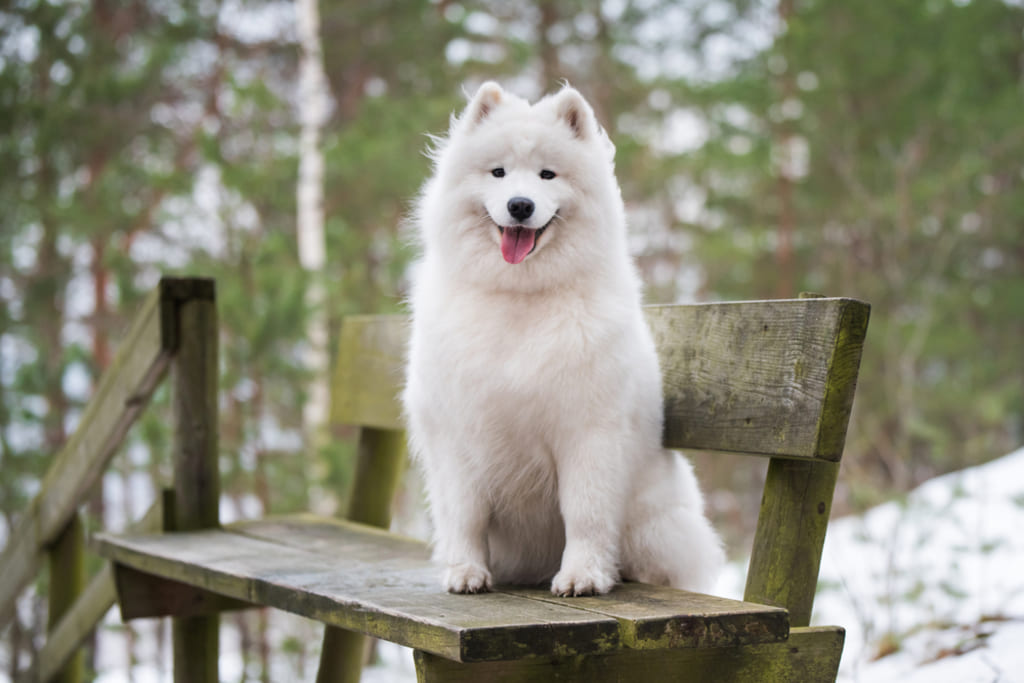
The Samoyed hails from Russia. The ancestors of Samoyeds were the Nenets Herding Laika, a kind of spitz used for herding reindeer in northern Siberia. Back then, the Nenets people, who were sometimes called Samoyeds, had these dogs. This is where the breed got its name from.
Studies using DNA tell us that Samoyeds are an old breed, older than many others that popped up in the 19th century. A study even looked at ancient dog remains from around 100 years ago, linking them to older dogs from 2,000 and 850 years ago. It shows that the Samoyed’s roots go way back in that area.
In the late 1800s, during prep for a trip to the North Pole, explorer Nansen Johansen got 33 dogs from the Nenets people. Although 28 went on the journey, sadly, none made it. But the pups born on the ship during the trip, mostly white, ended up becoming the first Samoyeds. According to Nansen, these dogs were strong, hardworking sled pullers and even helped in hunting polar bears.
Because of their job as sled dogs in harsh conditions, smaller ‘toy’ versions of Samoyeds didn’t exist back then—they wouldn’t have survived the extreme Arctic challenges. However, later on, explorer Fridtjof Nansen introduced miniature Samoyeds, called teacup Samoyeds, for his expeditions. But these smaller ones weren’t as tough and aren’t as common today.
The Samoyede people really adored these dogs, treating them like family. They’d even share their huts with them for warmth, creating a deep bond of companionship, loyalty, and trust that Samoyeds still have today.
In the late 1800s, these dogs made their way to England, often given as gifts from the Russian Czar. Queen Alexandria was a big fan, and many of today’s English and American Samoyeds come from her kennels. The official standards for Samoyeds were set in 1909 in England.
The Samoyed got its official start in the United States back in 1906 when a dog named Moustan of Argenteau got registered by the American Kennel Club (AKC). Though they were already popular among mushers in North America, this recognition by the AKC was a big deal—it put Samoyeds on the map as a top-notch, show-ready breed.
Appearance
Samoyeds are among the top large white dog breeds in the world. They have a sturdy, muscular, and well-proportioned physique.
Male Sammies, according to the AKC Standard, weigh between 45 to 65 pounds and stand 21 to 23.5 inches tall at the shoulder, while females weigh 35 to 50 pounds and stand 19 to 21 inches tall. The UK Kennel Club Standard sets slightly different measurements.
| Weight Range | Height Range | |
| Male | 45 to 65 pounds | 21 to 23.5 inches |
| Female | 35 to 50 pounds | 19 to 21 inches |
Their eyes, usually black or brown and almond-shaped, must not be blue for show. In the Spitz family, Samoyeds fall under the “brown and black section. Samoyed ears are furry, triangular, and stand erect, mostly white, but can have a light to dark brown tint.
Their distinct curled tail sets them apart. Unlike the Alaskan Malamute, it touches the back, often resting on one side. In chilly weather, they might even use their tails to warm their noses. When relaxed, their tails fall but curl up when alert.
Those signature smiles? They actually served a purpose, stopping drool from freezing on their faces during those challenging journeys.
The Samoyed shares genetic similarities with the wolf.
Coat and Color
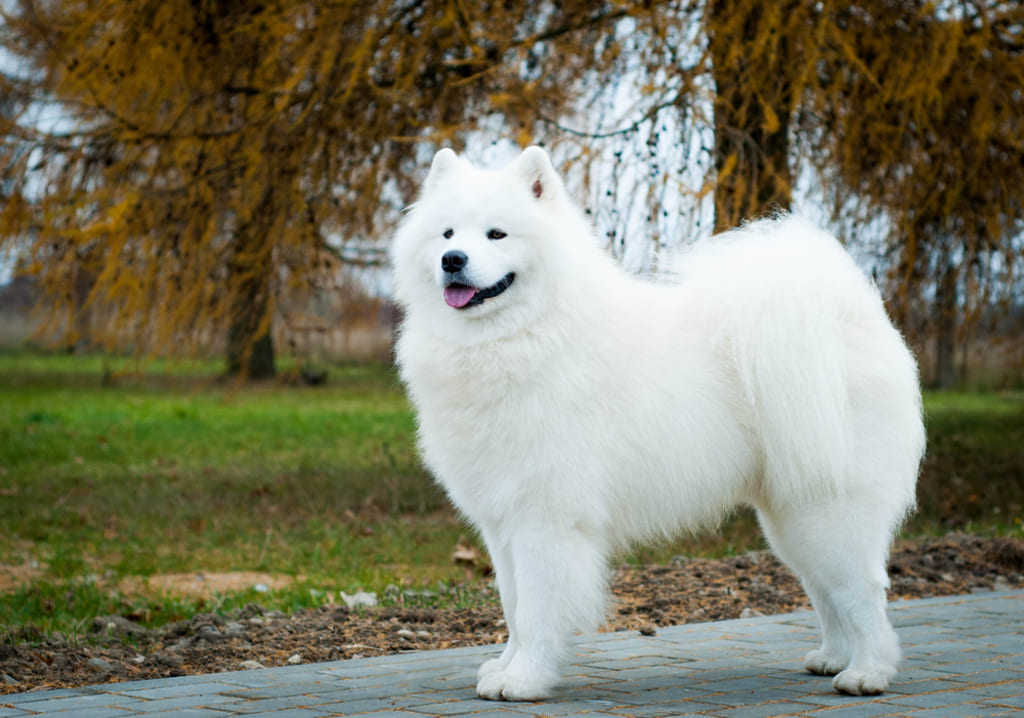
Sammies are famous for their big smiles and stunning fluffy white coats. Their fur can be pure white, white, cream, or biscuit, and it’s super fluffy with no specific markings. They rank among the best polar bear dog breeds.
Their coat is like a cozy jacket, with two layers—a dense undercoat and a straight topcoat. This keeps them comfy in different weather, keeping them warm in the cold and cool in the heat. The outer layer’s longer hairs trap cool air, while the dense undercoat keeps them snug. But in warm weather, they might get too hot because of this double coat.
Because of this thick coat, they shed a lot, especially during spring and autumn, for about two to three weeks. Regular grooming is a must—daily brushing when they’re shedding and about twice a week when they’re not, to keep their coat tidy and healthy.
Their dense double-layered coat comprises long, straight guard hairs with a silver tint atop a soft undercoat for warmth. Interestingly, their shed fur resembles angora wool and is used for knitting or creating artificial flies for fishing. If you have a Samoyed at home, you can buy a vacuum cleaner for pet hair to keep your home clean.
Characteristics and Temperament
Sammies are friendly and gentle and love being around their family. They thrive on companionship and the love and attention of their owners.
Because they’ve worked with other animals in the past, they usually just need basic socializing to stay super friendly. But watch out for their instinct to chase smaller animals—they might need a bit of training to keep that in check.
Being left alone for long periods can be really tough for these social dogs, leading to changes in their behavior, like digging up the yard or wrecking furniture.
They’re playful even as they grow older, always up for hanging out with the family and making friends with other dogs. Having a backyard where they can roam and play is a big plus, but make sure it’s safely enclosed because they tend to wander off.
They’re okay in warm weather, but don’t be surprised if your Samoyed prefers the cold. Snowy days are like a party for them! They adore playing outside in the snow or even lounging in a pile of it. Some owners even set up icy kiddie pools for them in summer as a special treat.
Smart and a bit stubborn, Sammies can be a challenge to train since they get bored easily with repetition. Agility training can be a great way to keep them interested and engaged.
These dogs are quick learners— they can figure out tricks like shaking hands and might even surprise you by learning to open doors. They’re also chatty, expressing their feelings with high-pitched barks, bellows, or growls when they’re happy or not so thrilled.
Health and Nutrition
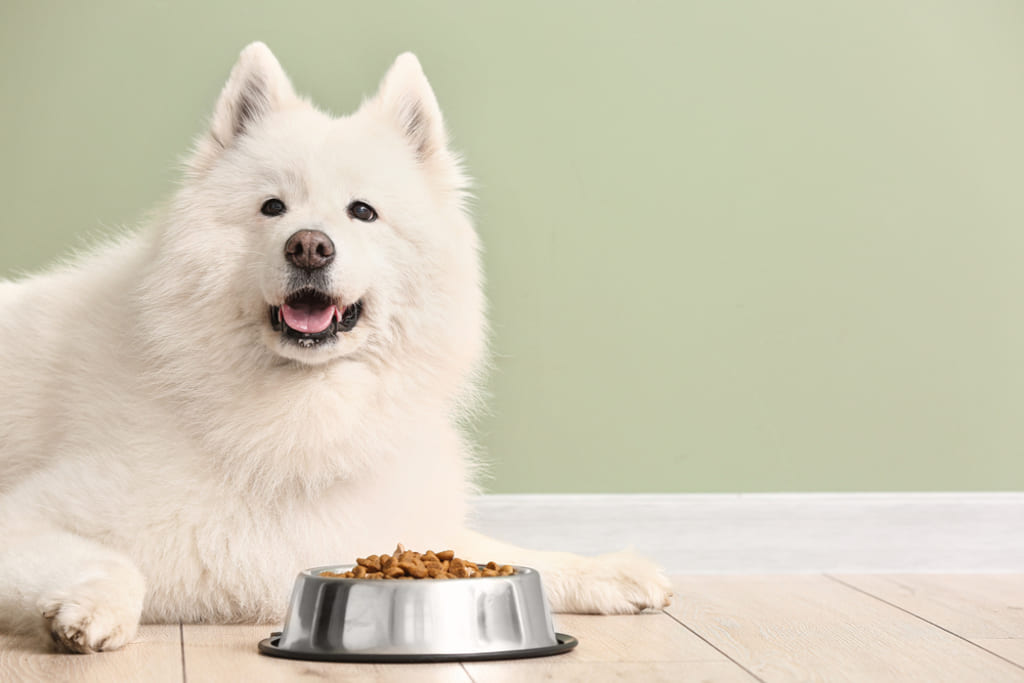
For Samoyed pups younger than a year, it’s essential to give them good quality puppy food approved by the AAFCO. Older ones, around 7 years and up, should switch to high-quality senior food that’s also AAFCO-approved.
If your Sammie is into herding, sledding, or lots of exercise, they’ll need dog food with more protein than regular house dogs. But if they’re more of a laid-back family pal, be careful not to overfeed or give too many treats to prevent them from packing on extra pounds.
For Samoyeds dealing with SHG, a protein-controlled diet can help slow down the disease. Feeding-wise, like many dogs, adult Sammies do well with two meals a day—morning and evening—and always keep fresh water available.
How much food? That usually depends on the ideal weight for adult Sammies, which typically ranges from 35 to 65 pounds. Most dog food packs have guidelines, and your vet can help figure out the right daily amount. For Samoyed puppies – the food portion will be based on their weight.
For active Sammies, think about adding joint-boosting supplements like glucosamine or omega-3 (fish oil) to their meals. Some dog foods specifically support joint health with added omega-3 or glucosamine.
Common Health Problems
The Samoyed breed, although they can live up to 14 years, can be prone to various health issues passed down through genes. These include eye and heart problems, hip dysplasia, and kidney disease, among others.
1. Uveodermatologic Syndrome (UDS)
This affects both the skin and eyes, causing skin lesions, depigmentation, and vision troubles. Treatments usually involve medications to calm down the immune system.
2. Eye Problems
Two common eye issues in Samoyeds are retinal dysplasia and progressive retinal atrophy. These can lead to vision problems and even blindness. There are DNA tests available to screen for these conditions, but sadly, there’s no specific treatment.
3. Glaucoma
Samoyeds can face eye problems like glaucoma, which can even lead to blindness. Watch for signs like swollen eyes or squinting, and watery eyes could be a clue, too.
4. Cataracts
As they age, cataracts might show up, making their eyes look cloudy. The good news is that surgery can often fix this!
5. Heart Troubles
Sammies might face heart issues like atrial septal defect (ASD), aortic stenosis, or pulmonic stenosis. These can lead to abnormal blood flow or other problems. Depending on the severity, treatments might include medication or even surgery.
6. Hip Dysplasia
It’s a condition where the hip joint doesn’t work right and can be painful. While genes play a role, other things like diet and exercise also contribute. Special tests can detect this, and treatments range from meds and supplements to surgery.
7. Samoyed Hereditary Glomerulopathy (SHG)
This genetic kidney problem affects the kidney filter and can lead to kidney failure by around age 5. There’s a DNA test for this, but unfortunately, there’s no cure. Medications and a special diet might help slow things down a bit.
8. Obesity
Watch out for weight gain—obesity can cause trouble for their joints and bones. It’s crucial to feed them the right amount and give them treats in moderation to keep them healthy.
9. Diabetes Mellitus
Diabetes mellitus in Samoyeds is a bit like human Type I diabetes, where the pancreas can’t make enough insulin. It usually shows up around middle age, at about seven years old.
Behavior and Training
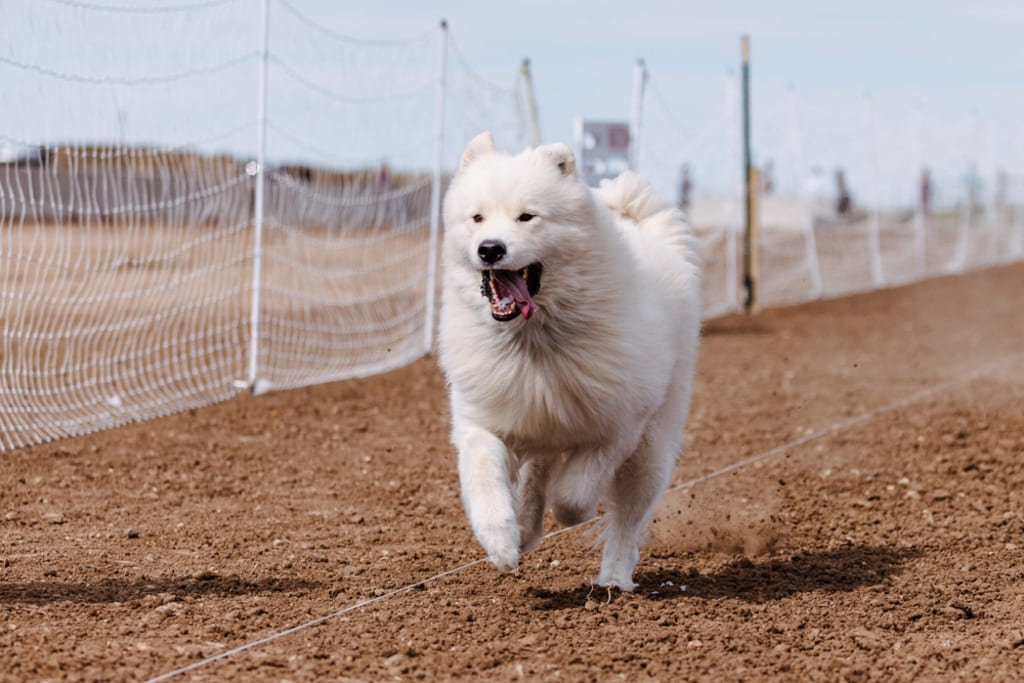
The Samoyed is a friendly and playful buddy, perfect for families. They’re quite vocal, often barking, growling, or whining when they’re excited. Meeting new people and dogs? They’re all for it!
These dogs are bundles of energy, so it’s important to keep them in a fenced yard or on a leash during walks to prevent wandering off. As for behavior, they need lots of exercise and space to play. If they feel cooped up or bored, they might start getting anxious and causing a bit of trouble.
When it comes to training, starting early is key. Sammies are smart cookies and usually take well to training. They love tasks and can learn to do all sorts of things, from herding to agility.
Training a Samoyed puppy can be straightforward once you cover the basics, as these dogs love bonding with their humans and aim to please them. But sometimes, they can be a bit stubborn. Start obedience lessons when they’re around seven to eight weeks old. Activities like nose work, agility, or herding tap into their natural talents and make training more fun!
Exercise Needs
Samoyeds need lots of exercise, more than many other active breeds. They thrive with at least two hours of daily activity, like running, long walks, or playing games, along with quality time with their owners.
If a Samoyed feels neglected, they might act up because they’re not getting enough physical and mental stimulation. Giving them extra attention and playtime helps keep them happy. They’re friendly with other dogs, so having a furry buddy around is a great way to make sure they get enough exercise.
Grooming Needs
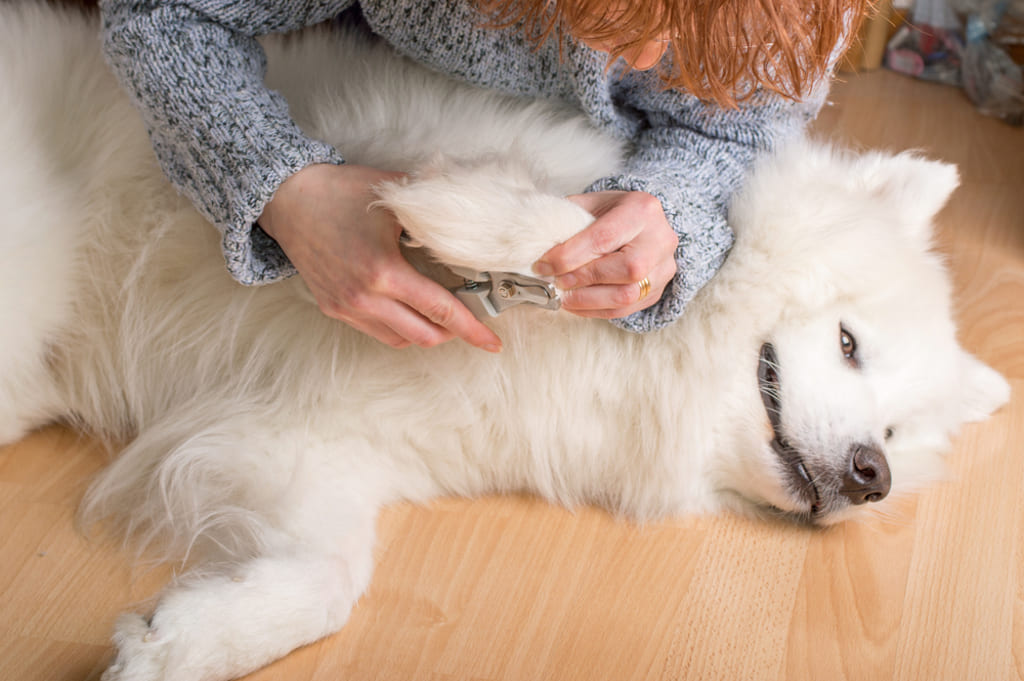
Sammies have high grooming requirements as they shed a lot during spring and summer.
1. Coat Care
The Samoyed boasts a double-layered coat—long topcoat and soft undercoat—that needs regular brushing to maintain its beauty.
Regular brushing helps manage their moderate shedding and keeps the coat in good condition. Consider using a de-shedding brush, especially during warmer seasons, to manage excess shedding.
2. Bathing Routine
Bathing isn’t a frequent task for Samoyeds unless they get notably dirty or messy.
After a bath, make sure to thoroughly dry their coat using a large towel or a gentle setting on a hairdryer.
3. Eye Care
Regular annual check-ups with a vet can help monitor and address potential eye issues that Sammies might be prone to.
4. Ear Care
Keep an eye on their ears, especially after baths or outdoor adventures. Use a dog-specific ear cleaner to ensure cleanliness and prevent any potential issues.
5. Nail Trim
You also need to trim their nails from time to time and check their paws for any signs of infection.
6. Dental Health
While Sammies aren’t prone to dental problems, it is still necessary to brush their teeth once or twice a week.
Are Samoyeds Hypoallergenic?
This might come as a surprise to you, given Samoyed’s shedding fur, but the breed is actually considered hypoallergenic. Although people often link hypoallergenic dogs with small breeds sporting tight curls or sleek, straight hair, the Samoyed doesn’t quite fit that mold. Even with all that fluffy fur, Sammies actually have low levels of dander, a significant allergen source.
Price
Samoyed puppies for sale range between $1,500 and $4,000, but the price can shoot up to $6,000 for top-quality ones from well-known breeders.
Samoyed price depends on the breeder’s reputation, location, and the pup’s family tree. Reputable breeders who stick to ethical practices and care deeply for their puppies usually charge more.
They provide health checks, vaccinations, and sometimes even microchipping. While the initial cost might be higher, it often means fewer medical worries at the start.
Life Span
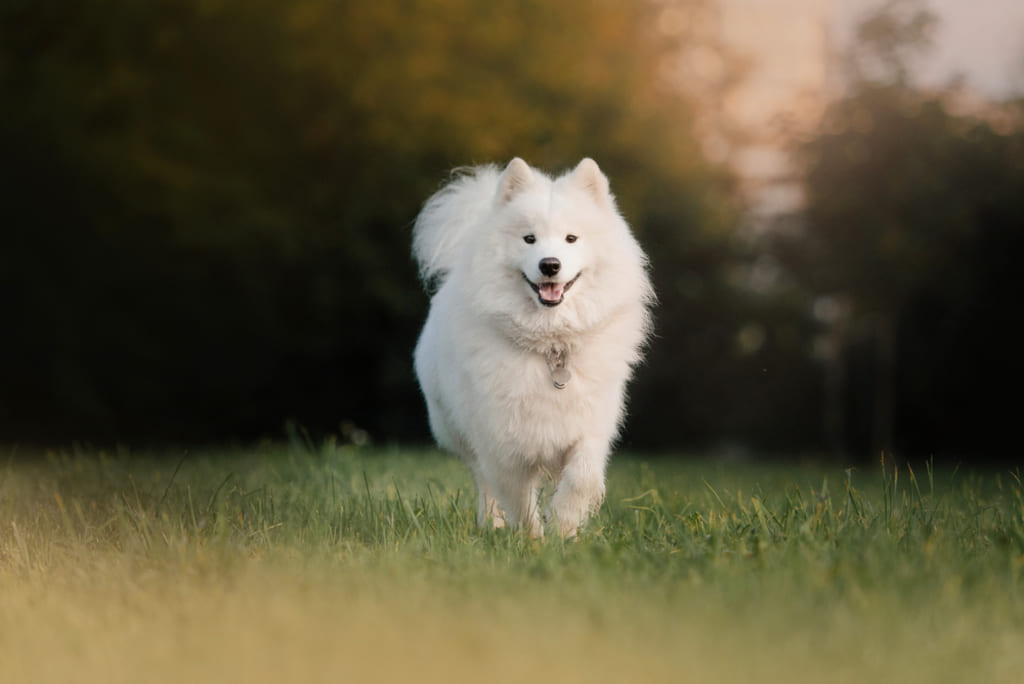
Sammies usually live between 12 to 14 years. Yet, how long they live can be affected by different things.
Genetics plays a big part in Samoyed’s life. Some health issues might be more common in certain bloodlines, so picking a responsible breeder matters a lot. They take steps to reduce these risks through their breeding practices.
FAQs
You can search online for Samoyed for sale to get a list of all the breeders selling the dog.
Despite their huge size, these dogs aren’t really aggressive. They are more on the friendly side.
No, Samoyed are not huskies; they are a different breed.
Conclusion
This is all you need to know about the Samoyed dog breed. If you love fluffy and cute dogs, Sammies are a good choice for your home. These dogs look as if they are always smiling and can win anyone over with their sweet disposition. These friendly teddy bears are good for families. However, remember that they need regular brushing and grooming along with exercise and entertainment. You need to devote time to play with them in order to keep them happy.
Explore Further:









